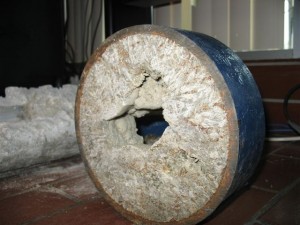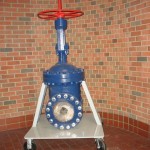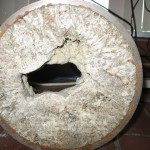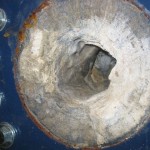
Cost Effective & Eco Friendly Solution
What Happens When You Can’t Remove Or Control Struvite?
In a U.S. wastewater plant, every year the 14” diameter line used to transfer sludge from an anaerobic digester to a sludge holding pond would have to be mechanically cleaned. Each year, the plant operation noticed that it took longer to transfer equivalent amounts of liquid from the digester. Finally, the maintenance department had to replace a valve and the photographs above show what they what they saw when they opened the valve.
Cost Effective Method To Remove or Control Struvite: TC 9325
At the U.S. wastewater plant, we ran a study with an environmentally safe product, TC 9325, and were quickly able to clean a pump and valve assembly. We found that it took just 2 lbs. of TC 9325 to remove 1 lb. of struvite. In our first test, we re-circulated a 30% (by weight) solution through a closed loop system that had a 2” build up in the pipeline, and 1” build up on the pump inlet and outlet. After recirculating for only 6 hours, we inspected the lines and the pump, and the lines were clean with trace amounts of a grayish film (A struvite deposit of less than 1/64”.). We tested the spent solution: the pH was 3.5; and we found soluble magnesium (chelated magnesium), ammonium phosphate, and carboxylic acid.
In another application, the plant manager had noticed a struvite build up in the overflow line from the digester, and in the elbows going to the sludge holding ponds. He said they were pumping 24 hours per day and could not maintain levels in the digester. Maintenance personnel checked the sludge pumps and discovered that the pumps were operating at a high backpressure. The plant manager purchased 2 drums of TC 9325 and made up a 30% (by weight) solution, which was fed into the digester overflow box, then filled the pipeline and let it sit overnight. The next morning they started up the transfer pumps and reported that they were able to get the levels in the digester down after only 18 hours instead of 24 hours. We checked back with the plant manager several months later and the pumps were controlling the sludge level in the digester with only 18 hours of operation.
Mechanically Cleaning: An Extremely Costly Solution
It is very costly to mechanically dig up and replace a line. What if the line is buried and is 14,000 feet long. Your replacement costs could run as high as $200 to $250 per linear foot, or anywhere from $2.8 million to $3.5 million dollars, plus any downtime costs.
Mechanical cleaning will use either a hydro-jetting system or a mechanical grinder. The hydro-jetting system will remove the soft loose struvite buildup, but will not dislodge the hard layered struvite build up. Using a mechanical grinder to remove struvite is a very labor intensive and time consuming project. Mechanical cleaning requires taking equipment out of service for weeks to months, which is costly.
Conventional Chemical Cleaning: A Harsh Solution
Chemical cleaning is another alternative. However, you need to understand that the type of chemicals used to remove hard layered struvite deposits are harsh conventional acids like HCL, H2SO4 and H3 (PO4). Not only will they dissolve the struvite, but they will also dissolve the calcium carbonate if it is present in the struvite crystal and most metal pipes and valves. Struvite is a magnesium ammonium phosphate (MgNH4PO4-6H20) compound, which is also called MAP. In most systems where MAP is a problem, you need to have a specific ratio of magnesium to ammonia to phosphate to precipitate struvite. In the majority of wastewater treatment plants, the major controlling factors are the magnesium level, CO2 release and pH. So to control the precipitation of struvite you need to control magnesium. For years, to control scale (calcium and magnesium), plants have used crystal modifiers. Recently, TC4 Solutions, Inc. found specific crystal modifiers that have the ability to re-solubilize magnesium from the MAP crystal. TC4 Solutions, Inc. noted that once you have removed the magnesium from the MAP crystal, the phosphate and ammonia goes back into solution and is easily removed. The rate of solubilizing magnesium from the MAP crystal is a function of concentration and time.
The Major Benefits of TC 9325:
- Fast Acting
- Safe On Equipment and Pipes
- Very Cost Effective
- Removes The Residual For New Struvite Growth
- Removes Struvite In The Hard To Reach Areas In The Lines
- Effective At Low Dosages
- Binds Up The Magnesium
- Environmentally safe for disposal


